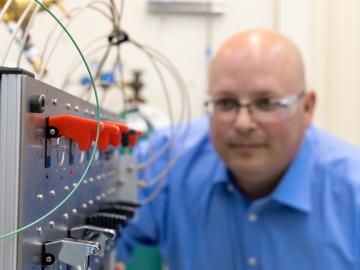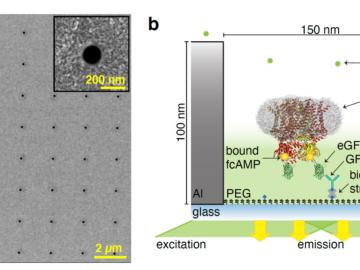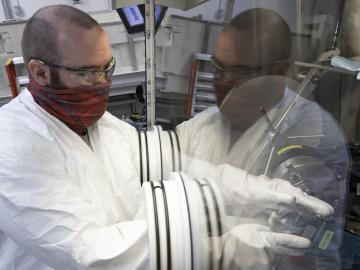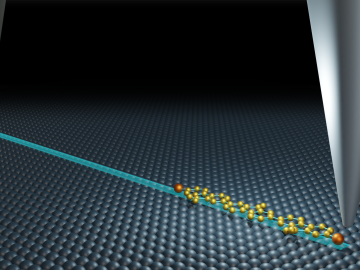
Filter News
Area of Research
- Advanced Manufacturing (2)
- Biology and Environment (5)
- Computer Science (1)
- Electricity and Smart Grid (1)
- Energy Science (15)
- Functional Materials for Energy (1)
- Fusion and Fission (2)
- Fusion Energy (1)
- Isotopes (7)
- Materials (28)
- Materials for Computing (7)
- National Security (3)
- Neutron Science (6)
- Nuclear Science and Technology (4)
- Quantum information Science (4)
- Supercomputing (15)
News Type
News Topics
- (-) Cybersecurity (9)
- (-) Frontier (10)
- (-) Isotopes (15)
- (-) Microscopy (21)
- (-) Polymers (15)
- (-) Quantum Science (18)
- (-) Space Exploration (11)
- 3-D Printing/Advanced Manufacturing (57)
- Advanced Reactors (18)
- Artificial Intelligence (33)
- Big Data (26)
- Bioenergy (26)
- Biology (31)
- Biomedical (18)
- Biotechnology (6)
- Buildings (31)
- Chemical Sciences (31)
- Clean Water (14)
- Composites (16)
- Computer Science (70)
- Coronavirus (15)
- Critical Materials (13)
- Emergency (2)
- Energy Storage (50)
- Environment (67)
- Exascale Computing (11)
- Fossil Energy (1)
- Fusion (19)
- Grid (28)
- High-Performance Computing (33)
- Hydropower (6)
- Irradiation (3)
- ITER (5)
- Machine Learning (19)
- Materials (70)
- Materials Science (54)
- Mathematics (3)
- Mercury (3)
- Molten Salt (6)
- Nanotechnology (25)
- National Security (13)
- Neutron Science (42)
- Nuclear Energy (36)
- Partnerships (11)
- Physics (11)
- Quantum Computing (9)
- Security (4)
- Simulation (16)
- Software (1)
- Statistics (1)
- Summit (11)
- Transportation (52)
Media Contacts

An Oak Ridge National Laboratory researcher has invented a version of an isotope-separating device that can withstand extreme environments, including radiation and chemical solvents.

Researchers working with Oak Ridge National Laboratory developed a new method to observe how proteins, at the single-molecule level, bind with other molecules and more accurately pinpoint certain molecular behavior in complex

Researchers from NASA’s Jet Propulsion Laboratory and Oak Ridge National Laboratory successfully created amorphous ice, similar to ice in interstellar space and on icy worlds in our solar system. They documented that its disordered atomic behavior is unlike any ice on Earth.

Sergei Kalinin, a scientist and inventor at the Department of Energy’s Oak Ridge National Laboratory, has been elected a fellow of the Microscopy Society of America professional society.

Oak Ridge National Laboratory scientists demonstrated that an electron microscope can be used to selectively remove carbon atoms from graphene’s atomically thin lattice and stitch transition-metal dopant atoms in their place.

To better understand the spread of SARS-CoV-2, the virus that causes COVID-19, Oak Ridge National Laboratory researchers have harnessed the power of supercomputers to accurately model the spike protein that binds the novel coronavirus to a human cell receptor.

Thirty-two Oak Ridge National Laboratory employees were named among teams recognized by former DOE Secretary Dan Brouillette with Secretary’s Honor Awards as he completed his term. Four teams received new awards that reflect DOE responses to the coronavirus pandemic.

A better way of welding targets for Oak Ridge National Laboratory’s plutonium-238 production has sped up the process and improved consistency and efficiency. This advancement will ultimately benefit the lab’s goal to make enough Pu-238 – the isotope that powers NASA’s deep space missions – to yield 1.5 kilograms of plutonium oxide annually by 2026.


Oak Ridge National Laboratory’s Center for Nanophase Materials Sciences contributed to a groundbreaking experiment published in Science that tracks the real-time transport of individual molecules.


